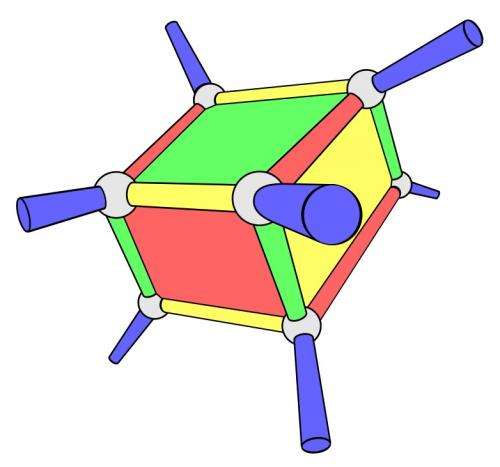June 11, 2013 feature
Physicists show self-correcting quantum computers are theoretically possible

(Phys.org) —Using exotic components such as color codes, new phases of quantum matter, and extra dimensions, a team of physicists has shown that it's theoretically possible to construct a quantum computer that has the ability to correct itself whenever an error occurs.
"The greatest significance of our work is showing that self-correcting quantum computing at a finite temperature is not impossible as a matter of principle," physicist Héctor Bombin told Phys.org. Bombin was at MIT in Cambridge, Massachusetts, while performing the study and is currently at the Perimeter Institute in Waterloo, Ontario. "In fact, the original motivation came from claims to the contrary by other authors. We provide explicit constructions that can be checked directly, without numerical simulations."
Bombin and his coauthors have published a paper on their proposed self-correcting quantum computer in a recent issue of the New Journal of Physics.
Error correction in quantum computers cannot be performed the same way as in classical computers, where information is stored multiple times for redundancy. Since copying quantum information is impossible due to the no-cloning theorem, physicists must find other ways to protect quantum information against errors.
As Bombin and his coauthors explain in their paper, quantum computers can be classified into three categories based on their protection against errors.
The first type is bare quantum computers, which do not have any type of error correction. These quantum computers have already been realized with ion traps and optical lattices.
The second type is externally protected quantum computers, which can be acted upon externally in order to repair errors. Although this type has not been successfully implemented yet, theoretical studies indicate that there are no fundamental obstacles to reach them when quantum technologies are fully developed.
The third type is internally protected (or self-correcting) quantum computers, which is the most demanding type because they can correct themselves whenever an error occurs. The standard classical computers that we use today are self-correcting, which is one of the properties that makes them so successful. But developing a self-correcting quantum computer is much more difficult. Illustrating just how difficult it is, the physicists say that the task will amount to finding a new quantum state of matter.
In their paper, the physicists theoretically showed how to construct a self-correcting quantum computer using a candidate for a new quantum state of matter called color codes. Color codes are a class of topological codes, which themselves have gained attention as a new phase of quantum matter due to their topologically ordered states. The physicists explain that color codes have very special transversality properties and a mathematical structure that is "colored."
In their model, the physicists constructed a color code in six and seven dimensions and explained how the code can be used to implement universal quantum computation that provides self-correction. To demonstrate the self-protection capabilities of the quantum computer, the physicists showed that it has a stable memory which, if exposed to a local noise for a short time, can preserve its quantum information.
If a self-correcting quantum computer could be built, it would have advantages over externally protected quantum computers, Bombin explained.
"External correction requires complex architectures involving enormous numbers of physical qubits to operate effectively on just a few logical qubits," he said. "If we had at hand suitable quantum phases of matter to use as quantum registers, architectures would dramatically simplify. In fact, the usual problem with conventional experimental approaches to quantum computing is scalability. In the case of self-correcting quantum computers, the problem is to find a suitable phase, but scalability should be much more straightforward."
Very recently, several other papers have been published that also address the possibility of self-correcting quantum computers. While some of these proposals are similar to the one here, the physicists note that these proposals do not work at a fixed temperature, while the one presented here does. Although each proposal has its own advantages, operating at a fixed temperature makes their model the most demanding and realistic scenario, although much more work is needed to build such a computer.
Among the challenges that the researchers face is lowering the dimensionality of their model.
"A major goal is to explore theoretically quantum phases of matter in two and three spatial dimensions with the goal of finding candidates for self-correcting quantum memories," Bombin said. "The self-correcting property is related to the confinement of excitations, and this may serve as a guide for research."
More information: H. Bombin, et al. "Self-correcting quantum computers." New Journal of Physics. 15 (2013) 055023. DOI: 10.1088/1367-2630/15/5/055023
Journal information: New Journal of Physics
© 2013 Phys.org. All rights reserved.





















